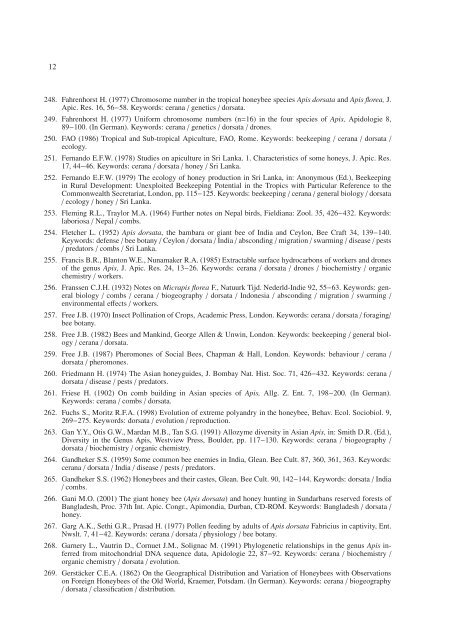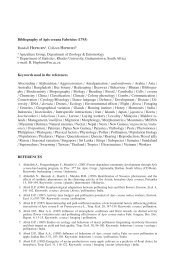H. Randall Hepburn, Colleen - Apidologie
H. Randall Hepburn, Colleen - Apidologie
H. Randall Hepburn, Colleen - Apidologie
You also want an ePaper? Increase the reach of your titles
YUMPU automatically turns print PDFs into web optimized ePapers that Google loves.
12<br />
248. Fahrenhorst H. (1977) Chromosome number in the tropical honeybee species Apis dorsata and Apis florea, J.<br />
Apic. Res. 16, 56−58. Keywords: cerana / genetics / dorsata.<br />
249. Fahrenhorst H. (1977) Uniform chromosome numbers (n=16) in the four species of Apis, <strong>Apidologie</strong> 8,<br />
89−100. (In German). Keywords: cerana / genetics / dorsata / drones.<br />
250. FAO (1986) Tropical and Sub-tropical Apiculture, FAO, Rome. Keywords: beekeeping / cerana / dorsata /<br />
ecology.<br />
251. Fernando E.F.W. (1978) Studies on apiculture in Sri Lanka. 1. Characteristics of some honeys, J. Apic. Res.<br />
17, 44−46. Keywords: cerana / dorsata / honey / Sri Lanka.<br />
252. Fernando E.F.W. (1979) The ecology of honey production in Sri Lanka, in: Anonymous (Ed.), Beekeeping<br />
in Rural Development: Unexploited Beekeeping Potential in the Tropics with Particular Reference to the<br />
Commonwealth Secretariat, London, pp. 115−125. Keywords: beekeeping / cerana / general biology / dorsata<br />
/ ecology / honey / Sri Lanka.<br />
253. Fleming R.L., Traylor M.A. (1964) Further notes on Nepal birds, Fieldiana: Zool. 35, 426−432. Keywords:<br />
laboriosa / Nepal / combs.<br />
254. Fletcher L. (1952) Apis dorsata, the bambara or giant bee of India and Ceylon, Bee Craft 34, 139−140.<br />
Keywords: defense / bee botany / Ceylon / dorsata / India / absconding / migration / swarming / disease / pests<br />
/ predators / combs / Sri Lanka.<br />
255. Francis B.R., Blanton W.E., Nunamaker R.A. (1985) Extractable surface hydrocarbons of workers and drones<br />
of the genus Apis, J. Apic. Res. 24, 13−26. Keywords: cerana / dorsata / drones / biochemistry / organic<br />
chemistry / workers.<br />
256. Franssen C.J.H. (1932) Notes on Micrapis florea F., Natuurk Tijd. Nederld-Indie 92, 55−63. Keywords: general<br />
biology / combs / cerana / biogeography / dorsata / Indonesia / absconding / migration / swarming /<br />
environmental effects / workers.<br />
257. Free J.B. (1970) Insect Pollination of Crops, Academic Press, London. Keywords: cerana / dorsata / foraging/<br />
bee botany.<br />
258. Free J.B. (1982) Bees and Mankind, George Allen & Unwin, London. Keywords: beekeeping / general biology<br />
/ cerana / dorsata.<br />
259. Free J.B. (1987) Pheromones of Social Bees, Chapman & Hall, London. Keywords: behaviour / cerana /<br />
dorsata / pheromones.<br />
260. Friedmann H. (1974) The Asian honeyguides, J. Bombay Nat. Hist. Soc. 71, 426−432. Keywords: cerana /<br />
dorsata / disease / pests / predators.<br />
261. Friese H. (1902) On comb building in Asian species of Apis, Allg.Z.Ent.7,198−200. (In German).<br />
Keywords: cerana / combs / dorsata.<br />
262. Fuchs S., Moritz R.F.A. (1998) Evolution of extreme polyandry in the honeybee, Behav. Ecol. Sociobiol. 9,<br />
269−275. Keywords: dorsata / evolution / reproduction.<br />
263. Gan Y.Y., Otis G.W., Mardan M.B., Tan S.G. (1991) Allozyme diversity in Asian Apis, in: Smith D.R. (Ed.),<br />
Diversity in the Genus Apis, Westview Press, Boulder, pp. 117−130. Keywords: cerana / biogeography /<br />
dorsata / biochemistry / organic chemistry.<br />
264. Gandheker S.S. (1959) Some common bee enemies in India, Glean. Bee Cult. 87, 360, 361, 363. Keywords:<br />
cerana / dorsata / India / disease / pests / predators.<br />
265. Gandheker S.S. (1962) Honeybees and their castes, Glean. Bee Cult. 90, 142−144. Keywords: dorsata / India<br />
/ combs.<br />
266. Gani M.O. (2001) The giant honey bee (Apis dorsata) and honey hunting in Sundarbans reserved forests of<br />
Bangladesh, Proc. 37th Int. Apic. Congr., Apimondia, Durban, CD-ROM. Keywords: Bangladesh / dorsata /<br />
honey.<br />
267. Garg A.K., Sethi G.R., Prasad H. (1977) Pollen feeding by adults of Apis dorsata Fabricius in captivity, Ent.<br />
Nwslt. 7, 41−42. Keywords: cerana / dorsata / physiology / bee botany.<br />
268. Garnery L., Vautrin D., Cornuet J.M., Solignac M. (1991) Phylogenetic relationships in the genus Apis inferred<br />
from mitochondrial DNA sequence data, <strong>Apidologie</strong> 22, 87−92. Keywords: cerana / biochemistry /<br />
organic chemistry / dorsata / evolution.<br />
269. Gerstäcker C.E.A. (1862) On the Geographical Distribution and Variation of Honeybees with Observations<br />
on Foreign Honeybees of the Old World, Kraemer, Potsdam. (In German). Keywords: cerana / biogeography<br />
/ dorsata / classification / distribution.




